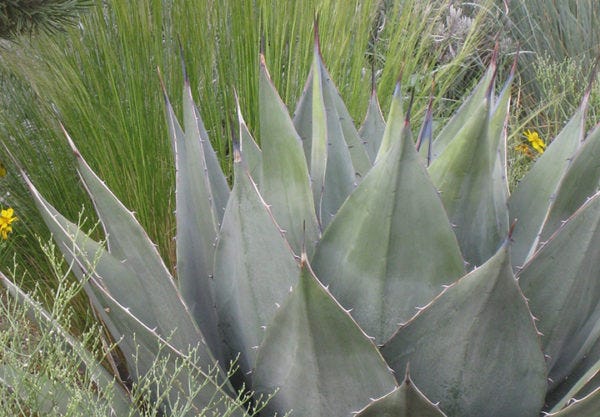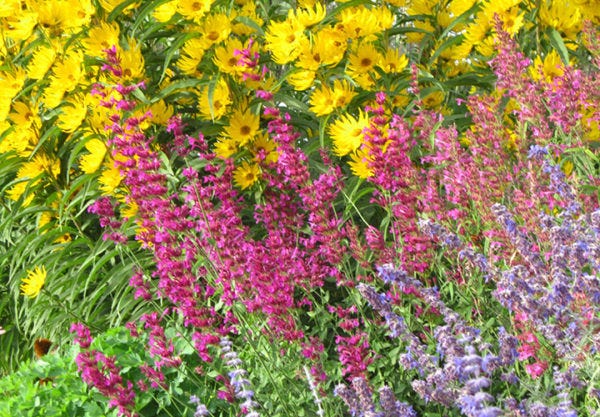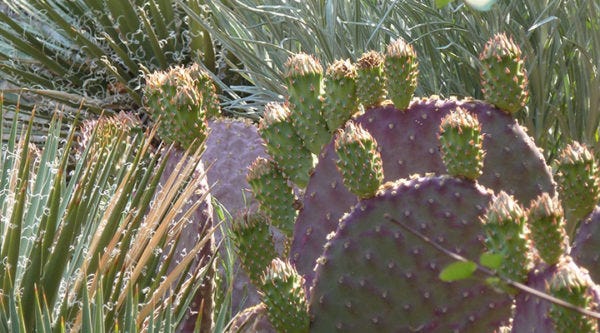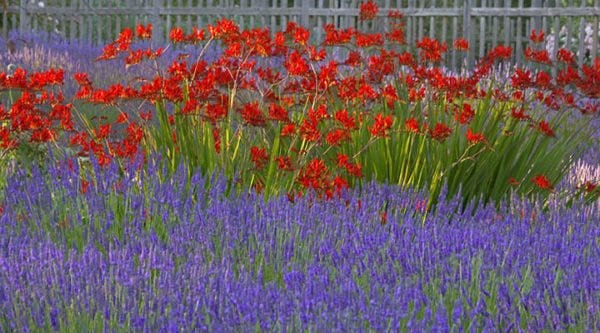Favorite Plant Combinations
by High Country Gardens

Lavandula angustifolia (English Lavender ), Tickseed (Coreopsis), Partridge Feather (Tanacetum) and Silky Thread Grass (Nasella)
Horticulturist David Salman's Favorite Combos
For me, the most satisfying element about gardening is when you create, either by plan or accident, wonderful plant combinations. Not only do companion plants make each other look better, but many plants actually grow better alongside compatible neighbors. I often make the analogy that putting a new plant into the garden is like assembling a new outfit. It's not done when you buy the jacket. It's all the other parts of the outfit like the pants, shirt, tie and socks that make the jacket really standout.

Muhlenbergia 'Pink Flamingo' and Bouteloua 'Blonde Ambition' (Blue Grama Grass), Salvia Raspberry Delight (in the rear).
Factors to Consider When Putting Together Plant Combinations
Make sure that the basic growing conditions preferred by the plants in the planting combination are a match. Here are the questions I ask myself before creating a combination planting:
- Do they like the same type of soil and soil pH?
- Are their watering requirements similar?
- Do they have the same sunlight needs?
- Are they matched for mature size and plant vigor? Don't plant a tiny rock garden species that grows one inch per year with a "race horse" that triples in size the first growing season and gets three feet tall.

Western gold mix Butterfly Weed and Sharon Roberts English Lavender
Design Considerations
Plant combinations are always more satisfying when using these basic design principles:
- When room allows, plant in groups of three or five plants of each species used in the combination. It makes for a more effective visual impact than putting one of each plant together.
- Be sure to understand the best angle from which the combination will be viewed and arrange accordingly. If planted against a wall, tallest plants go to the back while the shortest ones are up front.
- Put plants together that bloom at the same time and chose complementary colors or similar hues of the same color (like a shades-of-blue combination).

Agave haavardiana contrasted with Nasella and Helictotrichon
- Contrast foliage types and colors. Blue and gray foliage are nice together. Planting fine and bold textured foliage together makes a great combo.
- Consider making a group of plants that might be found together in their native habitat. For example, a grouping of South African perennials from the Drakensberg Mountains or a sampling of short grass prairie plants from TX, OK and KS. This is a fun way to re-create regional collections from across the globe in your landscape while teaching you more about the plants and where they come from.
A Few of My Favorite Combinations

Agastache Ava, Helianthus Santa Fe and Blue Spires Russian Sage (Perovskia)
Here are some combinations that work very well. Some are concepts (contrasting flower shapes) and some are specific plant combinations. It's mind-expanding to start thinking about all the wonderful ways plants can be woven together in the landscape.
- Agave or Yucca and ornamental grasses: Agave havardiana (Havard's Century Plant), Helictotrichon (Blue Avena Grass) and Nassella (Silky Thread Grass) create contrasting shapes, with soft sweeping movement of the grasses contrasting with the stationary cacti.
- Asclepias tuberosa (Orange Butterfly Weed ) and Lavandula (English Lavender) bloom together, creating a fabulous color combination.
- Contrasting ornamental grasses: Muhlenbergia 'Pink Flamingo' (Muhly Grass) and Bouteloua 'Blonde Ambition' (Blue Grama Grass) contrast shape and color with tall and rounded shapes and a contrast of blonde and pink colors.

Yucca, Silver Ironweed, and Opuntia come together in this lovely garden.
- Perovskia (Russian Sage), Agastache 'Ava' (Ava's Hummingbird Mint) and Helianthus 'Santa Fe' (Maximilian's Sunflower) feature big, bold plants and colors.
- Daisies and spiked bloomers (Agastache and Echinacea) contrast flower shapes, with a nice color mix.
- Vernonia lindheimeri v leucophylla (Silver Ironweed), Opuntia (Pad Cactus), Yucca (Yucca), Agave (Century Plant) add a pleasing geometry of foliage shapes in the landscape.
Bonus: Staff Favorite Combinations








© All articles are copyrighted by High Country Gardens. Republishing an entire High Country Gardens blog post or article is prohibited without written permission. Please feel free to share a short excerpt with a link back to the article on social media websites, such as Facebook and Pinterest.